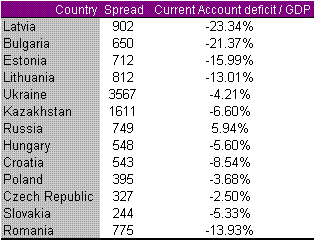Over the last five years a lot of local banks have been lending mortgages in other currencies, mostly in CHF but also JPY. Especially home owners in Poland – Hungary – Czech Republic are exposed, with a total amount of $ 1.6 tln linked to the consumer market. Since our report on this on 23rd of January the CHF strengthened further against those currencies by 15 %!
All this is putting pressure on domestic demand and is creating a vicious circle.
CEE countries were able to grow via foreign funding which came directly from West European banks which have been expanding in the region over the last decade by acquiring local banks. These West European banks are now facing on their turn further downgrades as their subsidaries already got downgraded by the rating agencies due to a very weak economic outlook.
Furthermore as capital ratio’s for Western banks in general come more under pressure, their capital allocation towards their CEE subsidaries will be streamlined as well. Capital allocation is based upon expected risk-adjusted returns and as risks are more pointing to the downside in the CEE region, West European banks will be very conservative towards funding their subsidaries. A good example is Citigroup’s decision to put its CEE franchise for sale.
And as the CEE region is depending on external funding this will put more pressure on growth and so a vicious circle is created.
Important to mention is that there are differences among the CEE countries what dependence on external debt concerns. If we look at the relation between the CDS spread of each of the countries compared to their current account deficit we get a good idea of the vulnerability of each country.
Table 1: 5y CDS Spread versus current account deficit - 2007

Source: Data from IMF world economic outlook database, April 2008
Bloomberg
As table 1 shows the Baltic states, Croatia and Bulgaria are heavily dependent on external funding. Russia, Ukraine and Kazakhstan are also under pressure but have a better current account number due to their natural resources.
Interesting to know is which Western European countries are via their banks exposed to CEE and to what extend? Moody’s recently wrote an interesting report on this, and we updated the figures based upon the database of Bank of International Settlements (BIS). We then compared their CEE exposure with their own GDP numbers.
As chart 1 shows most banks are based in either Austria, Belgium, Germany, Italy, France and/or Sweden and have appox. 85% of the total exposure of West European Banks. Austria has the biggest exposure on CEE. But the most worrying part is that almost 72% of their GDP is exposed to CEE loans.
This explains why the CDS spread of Austria is catching rapidly up with the one of Greece. Greece has still the highest CDS spread among the Euro-zone members with 254 bp above Euribor. However since February we see a rapid widening of Austrian credit spreads, and currently trading at 245 bp above Euribor, leaving the other PIGS (Portugal-Italy-Greece-Spain) countries behind them.
Do also note that Belgium’s credit spread is catching up with the PIGS countries due to its recent turmoil of KBC and Fortis. KBC had to go already for the second time in less then five months to seek for help at their local government for capital injections. In there recent earning report they were still up beat or less pessimistic about growth expectations in their second home market, being CEE. However they clearly differ from the official growth forecasts from the IMF and other public institutions.
Chart 1 Claims of Western European Banks on CEE countries

Source: BIS Consolidated Banking System – June 2008
See also Appendix
Table 2: CEE outstanding debt as % of GDP

Source: Data from BIS Consolidated Banking System and Worldbank
We share the conclusions of Moody’s that in first instance CEE banks will be extremely exposed to increasingly worsening economic conditions and will come under negative rating pressure against a background of depreciating currencies and large foreign currency lending.
West European Banks, in their search for improving their capital ratio’s might further prefer to lower the exposure to the CEE region or even digest such as Citigroup is already doing. This deleveraging process is going to put further pressure on CEE economies because of their dependence towards foreign funding, but this will also put further pressure on the group of West European Banks with considerable CEE franchises, as the deleveraging will further decline the market value of their consolidated balance sheets.
As a consequence some banks will have to revert back to their respective governments for additional capital injections. It is not impossible that some of these banks might even be pushed to the edge of nationalisation.
This unfavourable scenario is certainly dangerous for Austria, since their exposure expressed in terms of their GDP is considerable. In this case it might be possible that Austria need to ask for help at the EU and/or the IMF.
Appendix 1 Claims of Western European Banks on CEE countries

Source: Data from BIS Consolidated Banking System – June 2008
(1) Moody’s Global banking, February 2009
(2) Note that Poland has 50 % of its total bank loans outstanding in foreign currency. Source : BIS

No comments:
Post a Comment